1998 OPEL FRONTERA engine
[x] Cancel search: enginePage 1314 of 6000
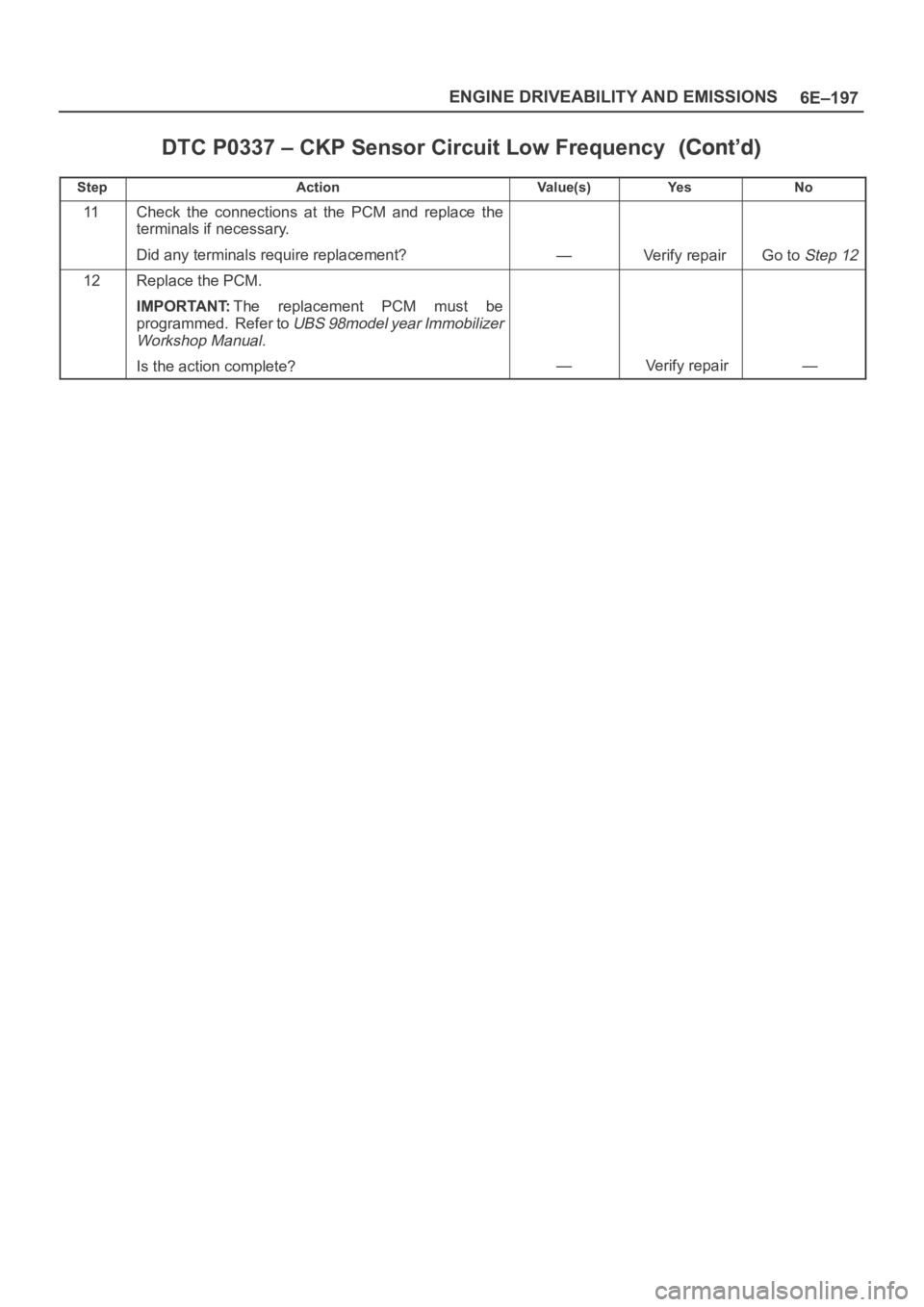
6E–197 ENGINE DRIVEABILITY AND EMISSIONS
DTC P0337 – CKP Sensor Circuit Low Frequency
StepNo Ye s Va l u e ( s ) Action
11Check the connections at the PCM and replace the
terminals if necessary.
Did any terminals require replacement?
—Verify repair Go to Step 12
12Replace the PCM.
IMPORTANT:The replacement PCM must be
programmed. Refer to
UBS 98model year Immobilizer
Workshop Manual.
Is the action complete?—Verify repair—
Page 1315 of 6000
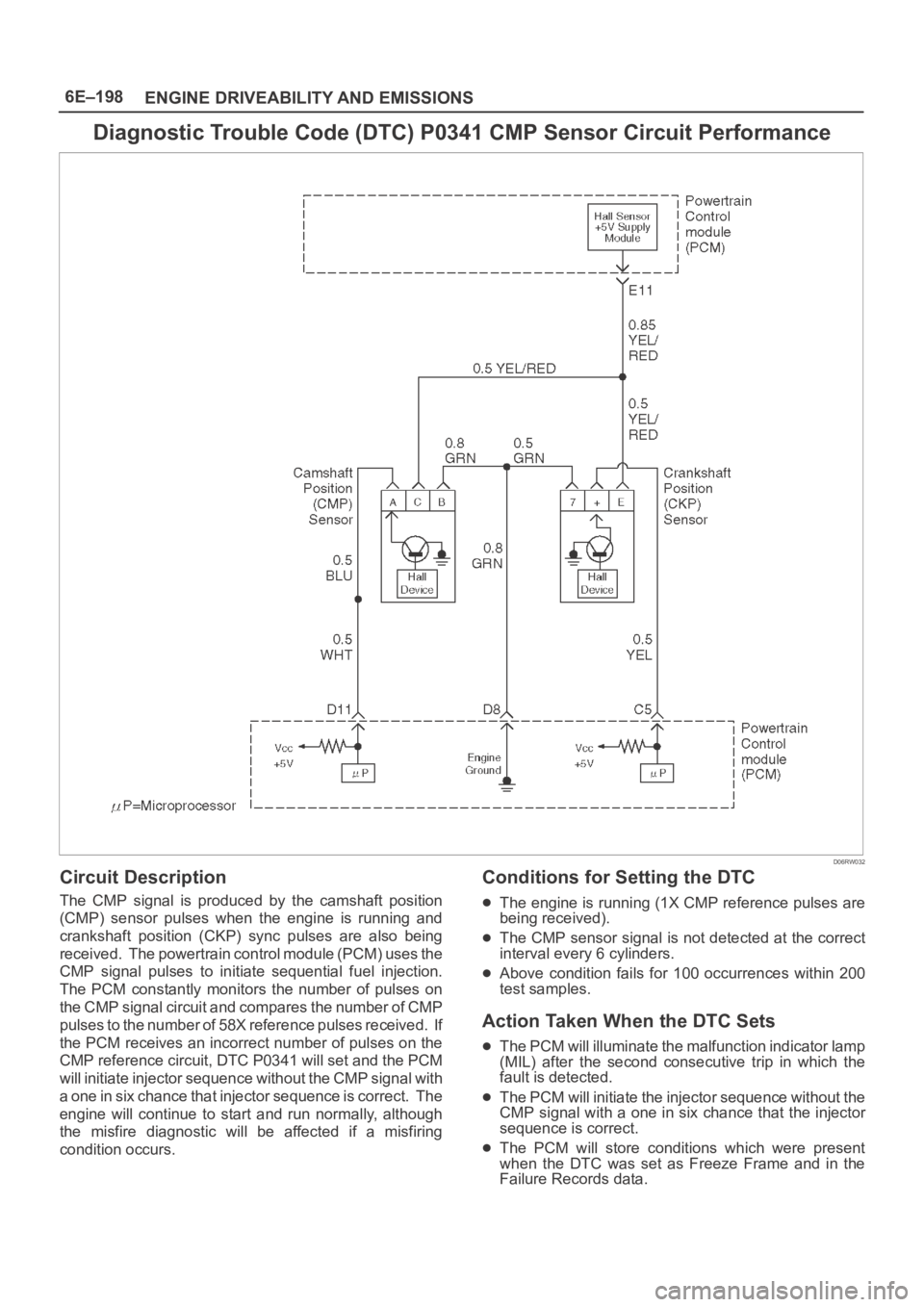
6E–198
ENGINE DRIVEABILITY AND EMISSIONS
Diagnostic Trouble Code (DTC) P0341 CMP Sensor Circuit Performance
D06RW032
Circuit Description
The CMP signal is produced by the camshaft position
(CMP) sensor pulses when the engine is running and
crankshaft position (CKP) sync pulses are also being
received. The powertrain control module (PCM) uses the
CMP signal pulses to initiate sequential fuel injection.
The PCM constantly monitors the number of pulses on
the CMP signal circuit and compares the number of CMP
pulses to the number of 58X reference pulses received. If
the PCM receives an incorrect number of pulses on the
CMP reference circuit, DTC P0341 will set and the PCM
will initiate injector sequence without the CMP signal with
a one in six chance that injector sequence is correct. The
engine will continue to start and run normally, although
the misfire diagnostic will be affected if a misfiring
condition occurs.
Conditions for Setting the DTC
The engine is running (1X CMP reference pulses are
being received).
The CMP sensor signal is not detected at the correct
interval every 6 cylinders.
Above condition fails for 100 occurrences within 200
test samples.
Action Taken When the DTC Sets
The PCM will illuminate the malfunction indicator lamp
(MIL) after the second consecutive trip in which the
fault is detected.
The PCM will initiate the injector sequence without the
CMP signal with a one in six chance that the injector
sequence is correct.
The PCM will store conditions which were present
when the DTC was set as Freeze Frame and in the
Failure Records data.
Page 1316 of 6000

6E–199 ENGINE DRIVEABILITY AND EMISSIONS
Conditions for Clearing the MIL/DTC
DTC P0341 can be cleared by using Tech 2 “Clear Info”
function or by disconnecting the PCM battery feed.
Diagnostic Aids
An intermittent may be caused by a poor connection,
rubbed-through wire insulation or a wire broken inside the
insulation. Check for:
Poor connection – Inspect the PCM harness and
connectors for improper mating, broken locks,
improperly formed or damaged terminals, and poor
terminal-to-wire connection.
Damaged harness – Inspect the wiring harness for
damage. If the harness appears to be OK, disconnect
the PCM, turn the ignition on and observe a voltmeter
connected to the CMP signal circuit at the PCM
harness connector while moving connectors andwiring harnesses related to the ICM and the CMP
sensor. A change in voltage will indicate the location
of the fault.
Reviewing the Failure Records vehicle mileage since the
diagnostic test last failed may help determine how often
the condition that caused the DTC to be set occurs. This
may assist in diagnosing the condition.
Test Description
Number(s) below refer to the step number(s) on the
Diagnostic Chart.
2. Ensures that the fault is present.
12.Determines whether the fault is being caused by a
missing camshaft magnet or a faulty sensor. The
voltage measured in this step should read around 4
volts, toggling to near 0 volts when the CMP sensor
interfaces with the camshaft magnet.
Page 1317 of 6000
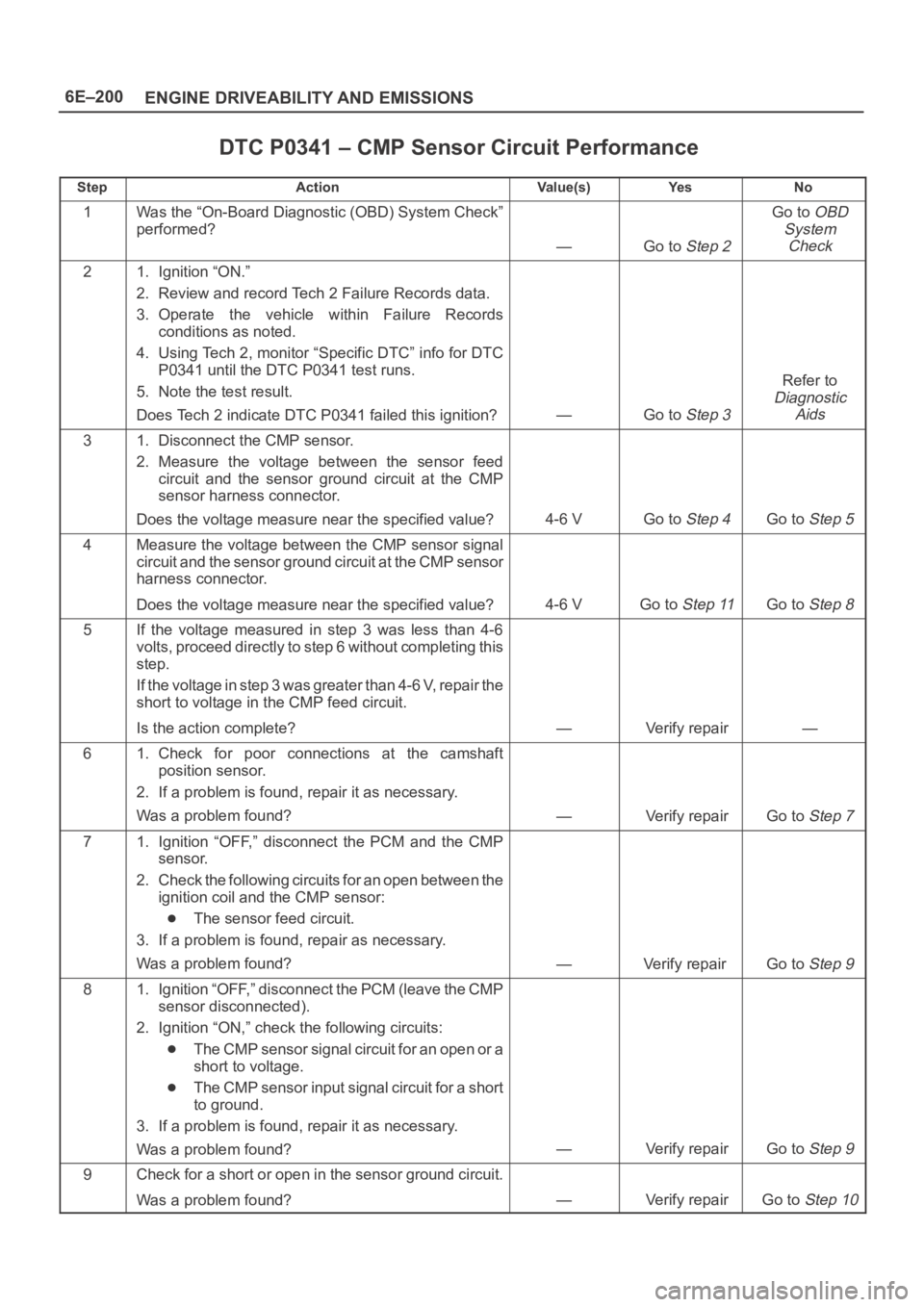
6E–200
ENGINE DRIVEABILITY AND EMISSIONS
DTC P0341 – CMP Sensor Circuit Performance
StepActionVa l u e ( s )Ye sNo
1Was the “On-Board Diagnostic (OBD) System Check”
performed?
—Go to Step 2
Go to OBD
System
Check
21. Ignition “ON.”
2. Review and record Tech 2 Failure Records data.
3. Operate the vehicle within Failure Records
conditions as noted.
4. Using Tech 2, monitor “Specific DTC” info for DTC
P0341 until the DTC P0341 test runs.
5. Note the test result.
Does Tech 2 indicate DTC P0341 failed this ignition?
—Go to Step 3
Refer to
Diagnostic
Aids
31. Disconnect the CMP sensor.
2. Measure the voltage between the sensor feed
circuit and the sensor ground circuit at the CMP
sensor harness connector.
Does the voltage measure near the specified value?
4-6 VGo to Step 4Go to Step 5
4Measure the voltage between the CMP sensor signal
circuit and the sensor ground circuit at the CMP sensor
harness connector.
Does the voltage measure near the specified value?
4-6 VGo to Step 11Go to Step 8
5If the voltage measured in step 3 was less than 4-6
volts, proceed directly to step 6 without completing this
step.
If the voltage in step 3 was greater than 4-6 V, repair the
short to voltage in the CMP feed circuit.
Is the action complete?
—Verify repair—
61. Check for poor connections at the camshaft
position sensor.
2. If a problem is found, repair it as necessary.
Was a problem found?
—Verify repairGo to Step 7
71. Ignition “OFF,” disconnect the PCM and the CMP
sensor.
2. Check the following circuits for an open between the
ignition coil and the CMP sensor:
The sensor feed circuit.
3. If a problem is found, repair as necessary.
Was a problem found?
—Verify repair Go to Step 9
81. Ignition “OFF,” disconnect the PCM (leave the CMP
sensor disconnected).
2. Ignition “ON,” check the following circuits:
The CMP sensor signal circuit for an open or a
short to voltage.
The CMP sensor input signal circuit for a short
to ground.
3. If a problem is found, repair it as necessary.
Was a problem found?
—Verify repairGo to Step 9
9Check for a short or open in the sensor ground circuit.
Was a problem found?
—Verify repairGo to Step 10
Page 1318 of 6000

6E–201 ENGINE DRIVEABILITY AND EMISSIONS
DTC P0341 – CMP Sensor Circuit Performance
StepNo Ye s Va l u e ( s ) Action
101. Check for poor connections at the PCM.
2. If a problem is found, repair it as necessary.
Was a problem found?
—Verify repairGo to Step 11
11Backprobe the PCM connector with a DVM to monitor
voltage on the camshaft position input signal circuit
while cranking the engine with the sensor connected.
(Use rubber band, tape, or an assistant to keep the
DVM lead in contact with the sensor terminal during this
test.)
Does the voltage toggle between the specified values?
4-0 VGo to Step 15Go to Step 12
121. Remove the CMP sensor from the engine front
cover (leave the sensor wiring connected).
2. Place a magnet on the CMP sensor.
(If you use a magnet that is too small to cover the face
of the sensor, test on every part of the sensor face
because only a small area will respond to this test.)
Does the DVM display a voltage near the specified
value?
0 VGo to Step 13Go to Step 14
13Replace the faulty or missing camshaft position sensor
magnet.
Is the action complete?
—Verify repair—
14Replace the camshaft position sensor.
Is the action complete?
—Verify repair—
15Replace the PCM.
IMPORTANT:The replacement PCM must be
programmed. Refer to
UBS 98model year Immobilizer
Workshop Manual.
Is the action complete?—Verify repair—
Page 1319 of 6000
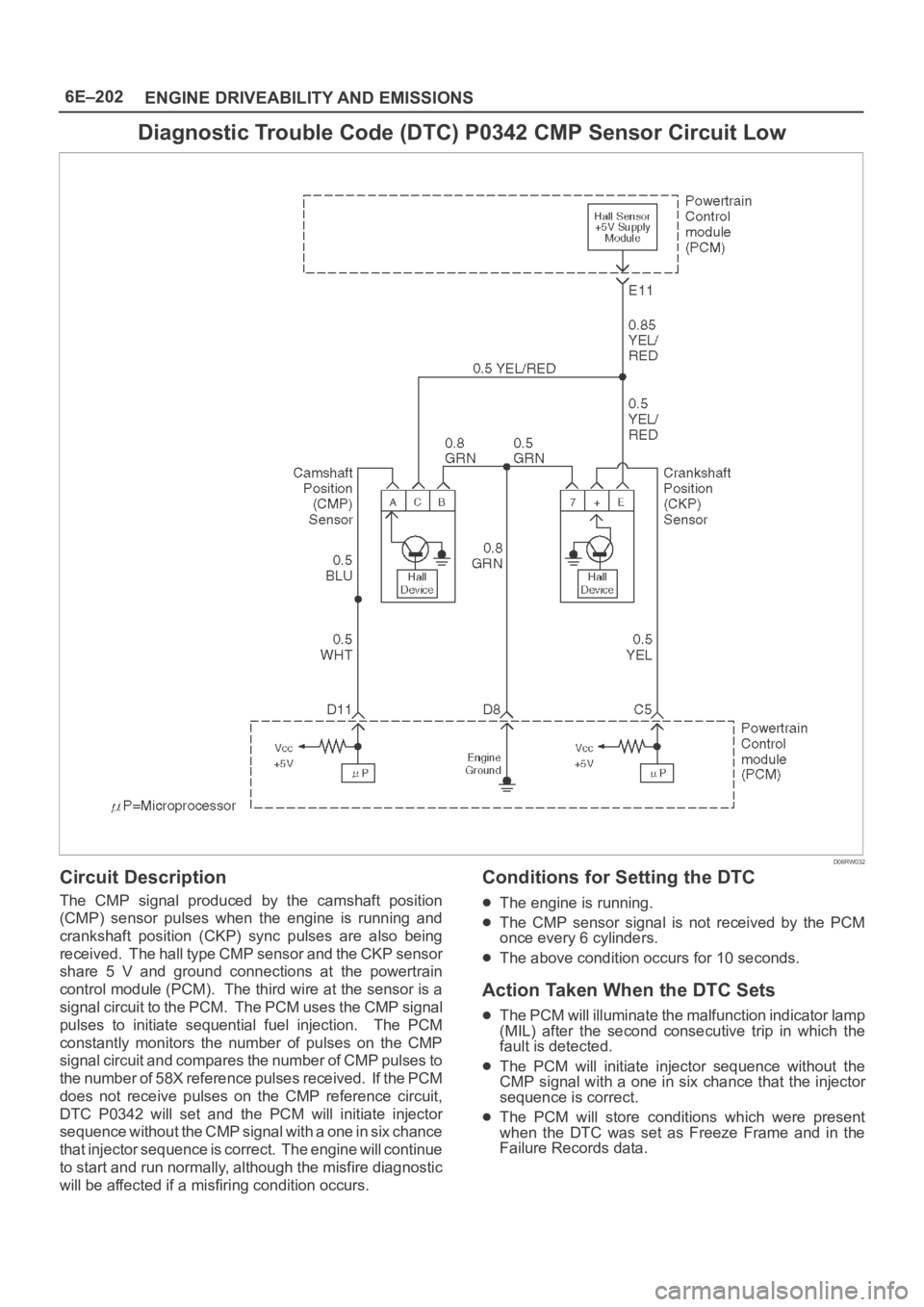
6E–202
ENGINE DRIVEABILITY AND EMISSIONS
Diagnostic Trouble Code (DTC) P0342 CMP Sensor Circuit Low
D06RW032
Circuit Description
The CMP signal produced by the camshaft position
(CMP) sensor pulses when the engine is running and
crankshaft position (CKP) sync pulses are also being
received. The hall type CMP sensor and the CKP sensor
share 5 V and ground connections at the powertrain
control module (PCM). The third wire at the sensor is a
signal circuit to the PCM. The PCM uses the CMP signal
pulses to initiate sequential fuel injection. The PCM
constantly monitors the number of pulses on the CMP
signal circuit and compares the number of CMP pulses to
the number of 58X reference pulses received. If the PCM
does not receive pulses on the CMP reference circuit,
DTC P0342 will set and the PCM will initiate injector
sequence without the CMP signal with a one in six chance
that injector sequence is correct. The engine will continue
to start and run normally, although the misfire diagnostic
will be affected if a misfiring condition occurs.
Conditions for Setting the DTC
The engine is running.
The CMP sensor signal is not received by the PCM
once every 6 cylinders.
The above condition occurs for 10 seconds.
Action Taken When the DTC Sets
The PCM will illuminate the malfunction indicator lamp
(MIL) after the second consecutive trip in which the
fault is detected.
The PCM will initiate injector sequence without the
CMP signal with a one in six chance that the injector
sequence is correct.
The PCM will store conditions which were present
when the DTC was set as Freeze Frame and in the
Failure Records data.
Page 1320 of 6000
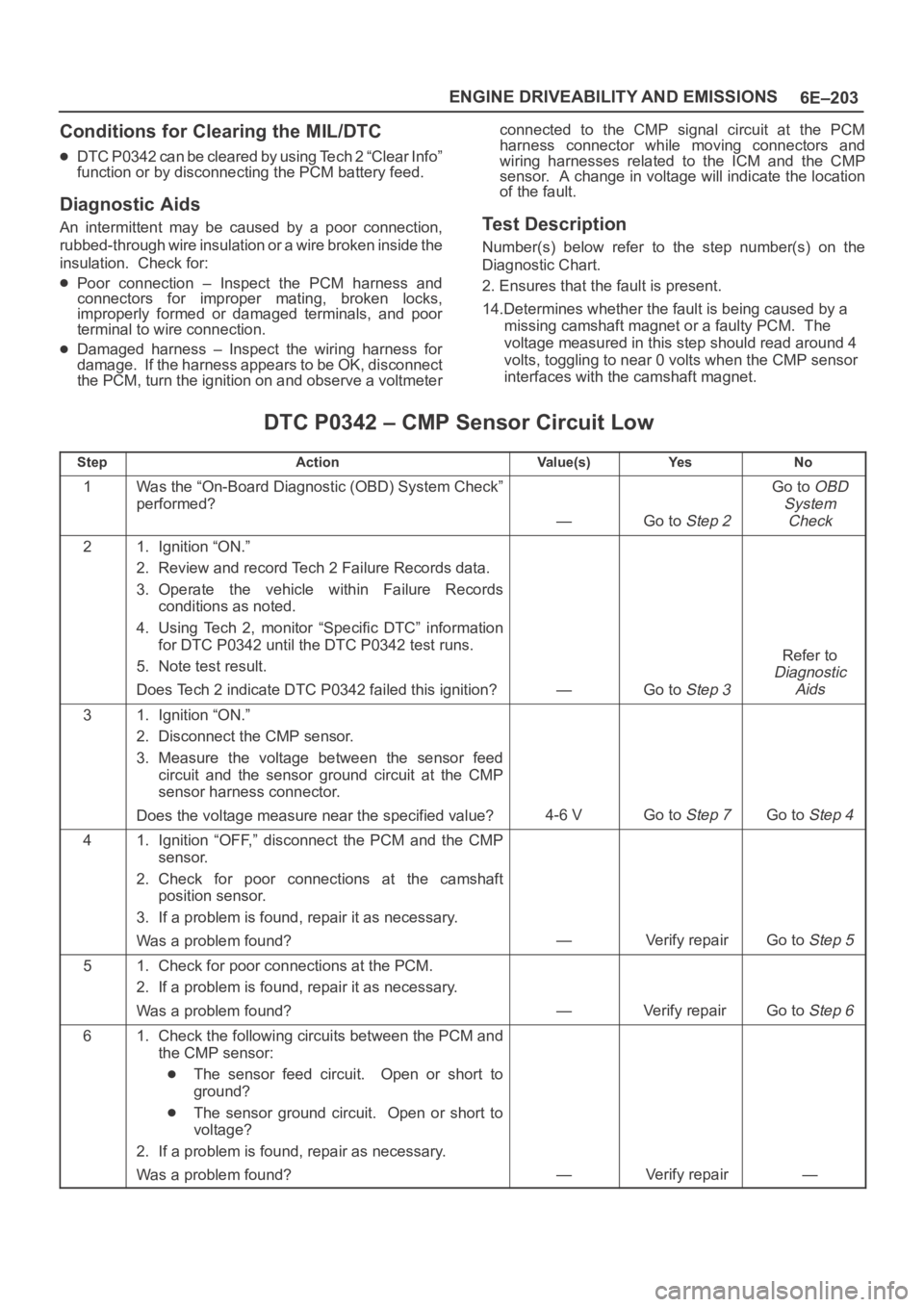
6E–203 ENGINE DRIVEABILITY AND EMISSIONS
Conditions for Clearing the MIL/DTC
DTC P0342 can be cleared by using Tech 2 “Clear Info”
function or by disconnecting the PCM battery feed.
Diagnostic Aids
An intermittent may be caused by a poor connection,
rubbed-through wire insulation or a wire broken inside the
insulation. Check for:
Poor connection – Inspect the PCM harness and
connectors for improper mating, broken locks,
improperly formed or damaged terminals, and poor
terminal to wire connection.
Damaged harness – Inspect the wiring harness for
damage. If the harness appears to be OK, disconnect
the PCM, turn the ignition on and observe a voltmeterconnected to the CMP signal circuit at the PCM
harness connector while moving connectors and
wiring harnesses related to the ICM and the CMP
sensor. A change in voltage will indicate the location
of the fault.
Test Description
Number(s) below refer to the step number(s) on the
Diagnostic Chart.
2. Ensures that the fault is present.
14.Determines whether the fault is being caused by a
missing camshaft magnet or a faulty PCM. The
voltage measured in this step should read around 4
volts, toggling to near 0 volts when the CMP sensor
interfaces with the camshaft magnet.
DTC P0342 – CMP Sensor Circuit Low
StepActionVa l u e ( s )Ye sNo
1Was the “On-Board Diagnostic (OBD) System Check”
performed?
—Go to Step 2
Go to OBD
System
Check
21. Ignition “ON.”
2. Review and record Tech 2 Failure Records data.
3. Operate the vehicle within Failure Records
conditions as noted.
4. Using Tech 2, monitor “Specific DTC” information
for DTC P0342 until the DTC P0342 test runs.
5. Note test result.
Does Tech 2 indicate DTC P0342 failed this ignition?
—Go to Step 3
Refer to
Diagnostic
Aids
31. Ignition “ON.”
2. Disconnect the CMP sensor.
3. Measure the voltage between the sensor feed
circuit and the sensor ground circuit at the CMP
sensor harness connector.
Does the voltage measure near the specified value?
4-6 VGo to Step 7Go to Step 4
41. Ignition “OFF,” disconnect the PCM and the CMP
sensor.
2. Check for poor connections at the camshaft
position sensor.
3. If a problem is found, repair it as necessary.
Was a problem found?
—Verify repairGo to Step 5
51. Check for poor connections at the PCM.
2. If a problem is found, repair it as necessary.
Was a problem found?
—Verify repair Go to Step 6
61. Check the following circuits between the PCM and
the CMP sensor:
The sensor feed circuit. Open or short to
ground?
The sensor ground circuit. Open or short to
voltage?
2. If a problem is found, repair as necessary.
Was a problem found?
—Verify repair—
Page 1321 of 6000
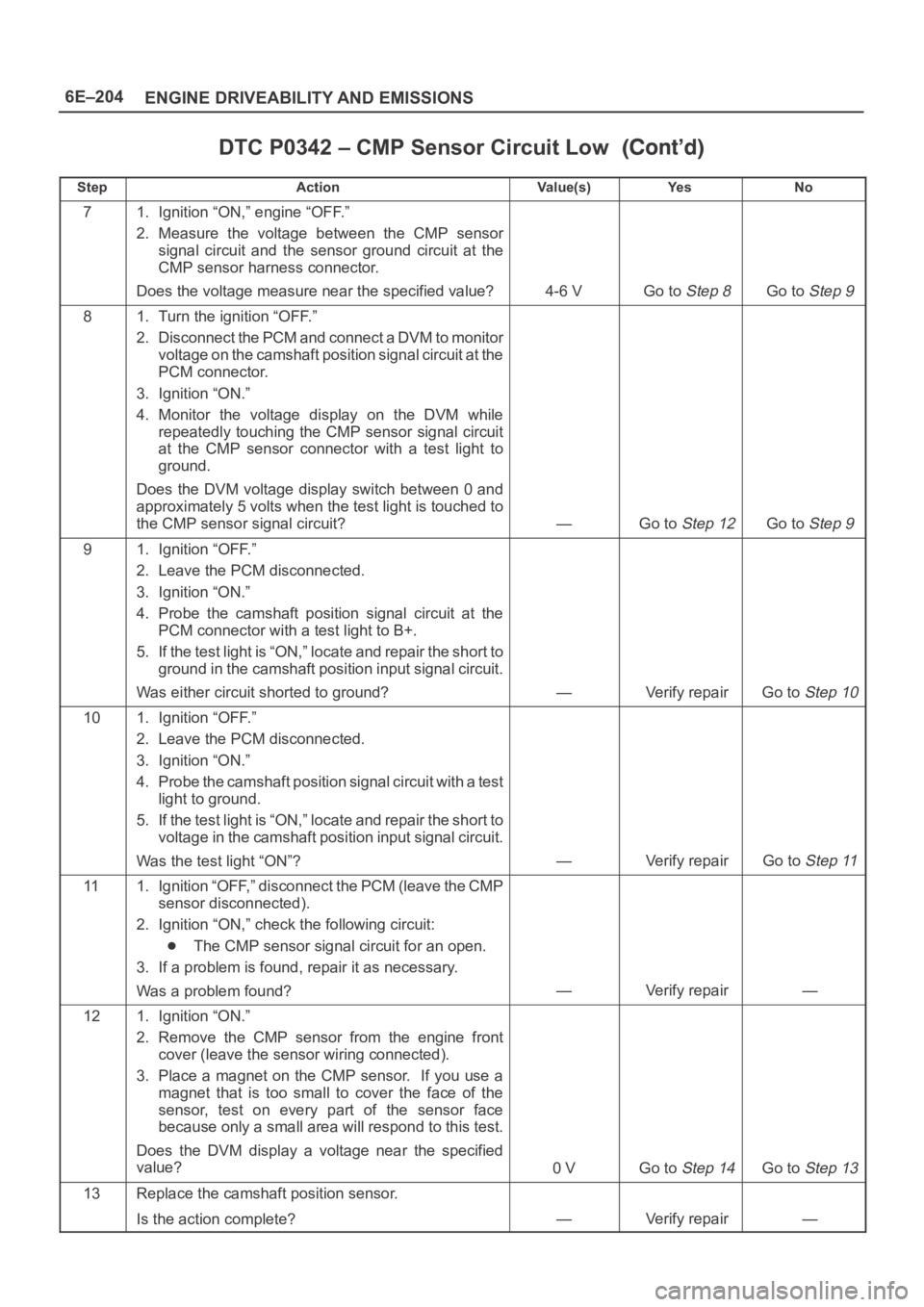
6E–204
ENGINE DRIVEABILITY AND EMISSIONS
DTC P0342 – CMP Sensor Circuit Low
StepNo Ye s Va l u e ( s ) Action
71. Ignition “ON,” engine “OFF.”
2. Measure the voltage between the CMP sensor
signal circuit and the sensor ground circuit at the
CMP sensor harness connector.
Does the voltage measure near the specified value?
4-6 VGo to Step 8Go to Step 9
81. Turn the ignition “OFF.”
2. Disconnect the PCM and connect a DVM to monitor
voltage on the camshaft position signal circuit at the
PCM connector.
3. Ignition “ON.”
4. Monitor the voltage display on the DVM while
repeatedly touching the CMP sensor signal circuit
at the CMP sensor connector with a test light to
ground.
Does the DVM voltage display switch between 0 and
approximately 5 volts when the test light is touched to
the CMP sensor signal circuit?
—Go to Step 12Go to Step 9
91. Ignition “OFF.”
2. Leave the PCM disconnected.
3. Ignition “ON.”
4. Probe the camshaft position signal circuit at the
PCM connector with a test light to B+.
5. If the test light is “ON,” locate and repair the short to
ground in the camshaft position input signal circuit.
Was either circuit shorted to ground?
—Verify repairGo to Step 10
101. Ignition “OFF.”
2. Leave the PCM disconnected.
3. Ignition “ON.”
4. Probe the camshaft position signal circuit with a test
light to ground.
5. If the test light is “ON,” locate and repair the short to
voltage in the camshaft position input signal circuit.
Was the test light “ON”?
—Verify repairGo to Step 11
111. Ignition “OFF,” disconnect the PCM (leave the CMP
sensor disconnected).
2. Ignition “ON,” check the following circuit:
The CMP sensor signal circuit for an open.
3. If a problem is found, repair it as necessary.
Was a problem found?
—Verify repair—
121. Ignition “ON.”
2. Remove the CMP sensor from the engine front
cover (leave the sensor wiring connected).
3. Place a magnet on the CMP sensor. If you use a
magnet that is too small to cover the face of the
sensor, test on every part of the sensor face
because only a small area will respond to this test.
Does the DVM display a voltage near the specified
value?
0 VGo to Step 14Go to Step 13
13Replace the camshaft position sensor.
Is the action complete?
—Verify repair—